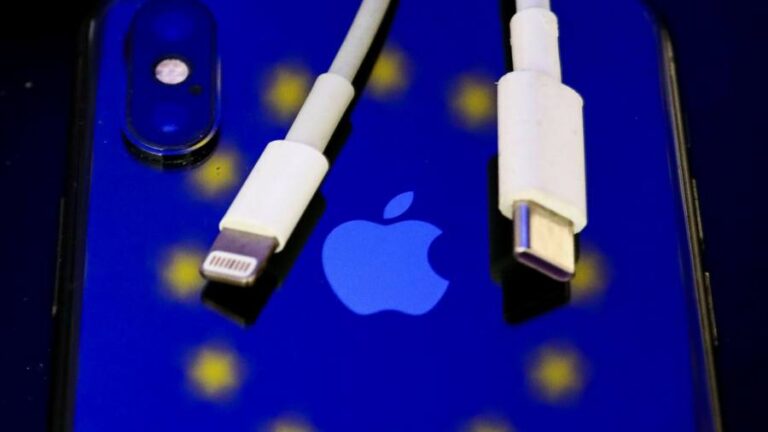
Steve Jobs had a clear design principle for Apple: “Let’s make it simple. Really simple,” he once declared. Jobs followed the Bauhaus movement’s emphasis on functionality and its maxim that “less is more”.
So I doubt whether Apple’s late co-founder would have tolerated the charging station by my desk at home, with two wireless charging pads and three cables with different connectors on the ends. It is there to power various devices, including an Apple Watch, an Amazon Kindle and a Canon camera, but is an unsightly mess.
The EU regards some of this proliferation of wires and chargers as Apple’s fault, since the company has persevered with its own Lightning connector for iPhones, rather than the USB-C ports adopted on other phones. This week, the European Parliament voted to make it and other rebels fall in line by 2024.
Might Jobs have secretly approved of its power play? The plan is attractive on the grounds of simplicity and consumer ease. But, judging by his operating philosophy that Apple should follow its own path and create intuitive, appealing products by overseeing every element, I cannot imagine he would.
I am similarly torn. My heart lies with the EU’s ambition to sweep away charger confusion definitively, and to impose use of the USB-C connector port for mobile devices from phones to cameras, headphones and portable games consoles. It estimates that it could save European citizens €250mn and eliminate thousands of tonnes of environmental waste each year.
Who has not delved hopefully into a bag of tangled wires, only to discover that the connector cable with a USB-A on one end and a USB-C on the other is missing? Or mislaid a USB-C to Lightning and scrabbled to fit a Micro-USB connector the right way round? Then we have to watch sadly as the red sliver on the battery indicator dims and the screen goes blank.
The European Commission has been on a long campaign against consumer electronics groups to end this frustration, starting with a voluntary agreement in 2009 to converge towards USB industry standards. This has had an effect: there were more than 30 proprietary chargers in use then and it has nudged that down to three.
Now it wants to ensure what Thierry Breton, EU single market commissioner, calls “full harmonisation”. The EU clearly has the market power to impose its will: the UK may not follow its edict in law but if anyone believes Apple will make a national iPhone for Brexit Britain, forgive me while I laugh. Indeed, what goes for Europe will probably go for the US and Asia, too: a global charger is efficient.
Apple is already converging. It now uses USB-C-compliant ports (which it calls Thunderbolt) for charging and connectivity on its MacBooks and iPads, although not on accessories such as AirPods, and is reported to have been testing iPhones with them. It would be foolish not to: having to use different chargers for iPhones and iPads is irritating.
Its change of tack was not just prompted by the threat of legislation; it is also about USB-C itself. After launching successive connectors that suffered the basic design flaw of only working one way up, the companies behind USB standards (including Apple) finally came up with a better one. No longer is every attempt to plug in a charger a fiddly experiment.
That is why my head doubts whether the EU should fix which connector is legal. It has been sensible to back industry standards rather than have the European Parliament design a Euro-charger (can you imagine?). But even so. Apple got ahead a decade ago with Lightning, and the innovation would have been barred if the EU had imposed the inferior Micro-USB.
Apple is not the only sceptic. You might expect USB’s backers to be pleased by EU intervention, but they are also opposed. “We told them repeatedly, we do not support legislation. You pass a law and then a year later the technology changes: it gets better or smaller or cheaper,” Jeff Ravencraft, president of the USB Implementers Forum, told me this week.
While the EU believes in enforcing unity, consumers are complex: we favour a single charger, except for when we don’t. Apple produced a MacBook Air with two USB-C ports in 2020, but this week released one with an added MagSafe charger that detaches if the cord is kicked, rather than pulling the laptop off a table.
This was by popular demand because, for all the appeal of USB-C, it is imperfect. USB may one day unveil a magnetic standard that both charges and connects devices but until then, it is preferable to have a choice. (The EU directive mandates at least one USB-C port, so this will be allowed on laptops).
It all leaves me torn. I prefer simplicity but I also like innovation, even in the mundane business of power. As technology goes wireless, a tussle over connectors may become less pressing, but the principle is important. A harmonised world that only had a single charger is very tempting, but we would not know what we were missing.